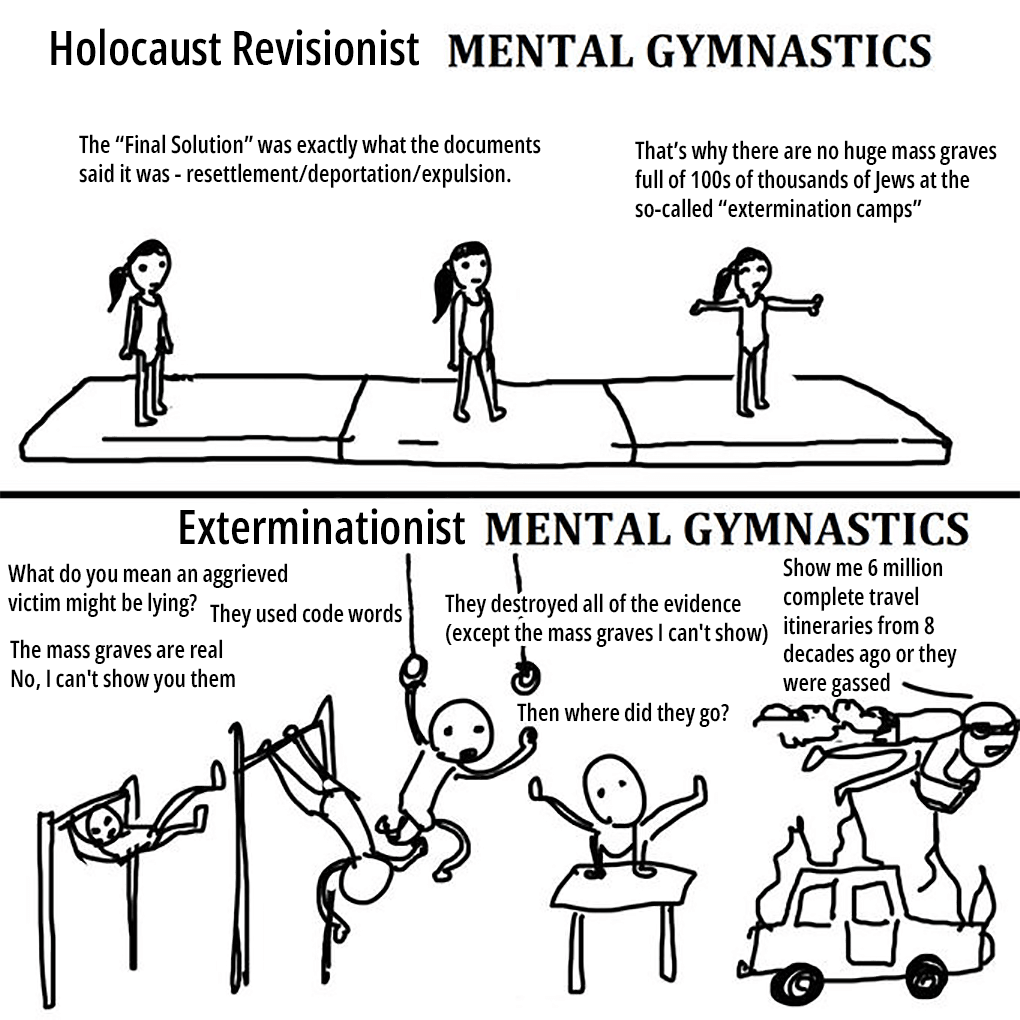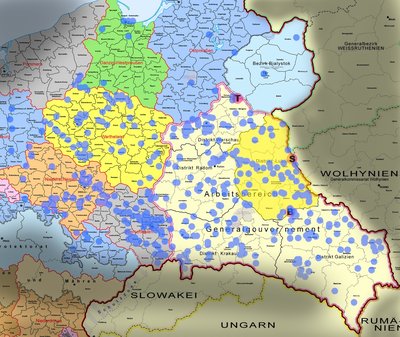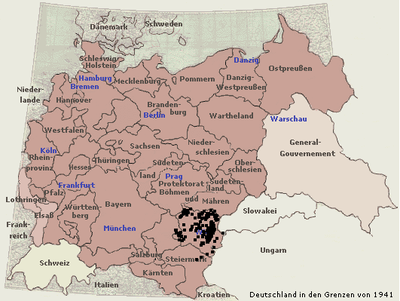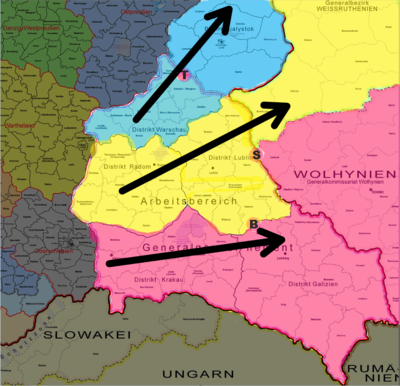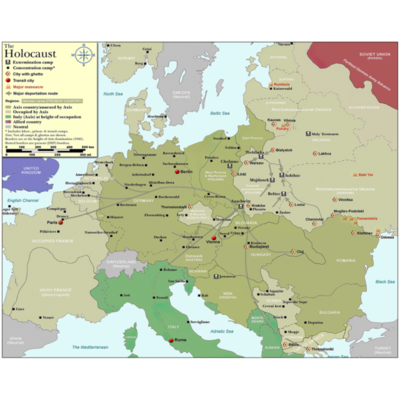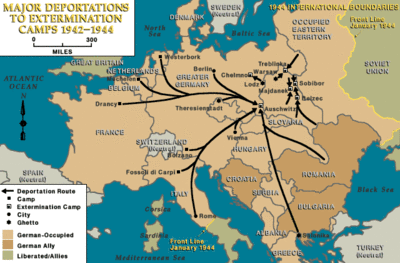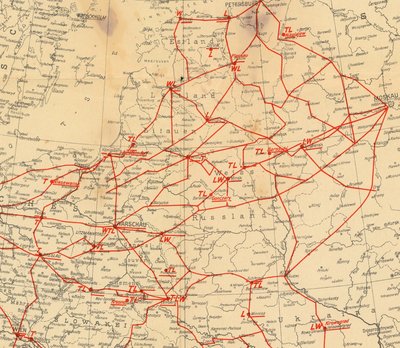This will be a long post but if you bear with me, I think you'll find it worthwhile. This is a map of the approximate location of many Zwangarbeitslager (labor camps) for Jews:
General Government Labor CampsThis map vastly understates the true number of these labor camps, first of all because many are "stacked" in the same place (sometimes dozens) with the points plotted, but also because (1) many of the labor camps which are known lack sufficient information to be mapped and (2) there are likely hundreds more (maybe thousands) which remain totally unknown. These do not include those in the East nor further south (e.g. Austria). It also does not include ghettos nor concentration camps/sites.
What it does do is provide an illustration of, generally, where these known labor camps were clustered, how they were patterned throughout German territory and relative to AR camps (also shown), etc.
I have been working with the data used to populate the map (see:
viewtopic.php?f=2&t=14794&p=107398#p107398) which, as already mentioned, includes many more camps than those plotted. In total, there are 1,030
known camps within the territories shown above. The breakdown is as follows:
Silesia = 213
Reichsgau Wartheland = 205
District Galicia = 164
District Lublin = 126
District Radom = 93
District Krakow = 84
District Warsaw = 72
Reichsgebiet = 40
District Bialystok = 7
Reichsgau Sudetenland = 17
Reichsgau Danzig-Westpreußen = 8
Reichsgau Oberdonau = 1
What is not known, for the most part, is the size of these camps. There are at least some confirmed to have had inmates numbering in the thousands but others were as low as in the dozens or hundreds.
Of the 1,030 total, here is some of the data which I found most important:
- 459 of these entries indicate the camp closing date is only assumed based on the time of its "last mention" ("letzte Erwähnung")
- 204 were reported (or assumed) closed no earlier than sometime in 1944 (with even mid-to-late 1944 not being uncommon)
- 20 were reported closed in 1945
- About 10-15% have no known closing date at all
- 346 of the 1,030 entries have no map location due to missing/insufficient information (many others have only an approximate location)
These areas and figures do not include those camps for Hungarian Jews in Austria, which are even more shocking:
Butterfangers wrote:Did you know......that the Zwangsarbeitslagers in Austria for Hungarian Jews included a whopping eighty-six (86) camps for Jewish
children? From what I can tell, nearly all of these camps opened up
during or after the main period in which half of Hungarian Jews are said to have been 'exterminated' in Auschwitz (15 May – 9 July 1944).
Use the Ctrl+F search function, here, for the search term "Kinder" ("children" in German):
https://archive.is/Gd3feMap of the Zwangsarbeitslagers in Austria:
Most of the camps with children opened in June '44, or within the months that followed. A couple of them opened 'circa June'; the sole children-only camp opened as early as April (Wien-Leopoldstadt). They typically stayed open approximately until the end of the war in Austria (late-April '45), sometimes even later.
At the precise time when Hungarian Jewish children were allegedly being "selected" for extermination at Auschwitz (based on the sole criteria of being a child), it is strange that Germany would also be setting up 86 camps for children nearby. Men and women were also housed at most of these camps. I wonder how old and/or infirm they might have been. Much of the labor seems like lighter work (electrical, glass-work, agricultural, textiles, cannery, etc.) than what is at some of the labor camps in other areas (quarry work, logging, etc.) or even at Auschwitz (construction, industrial, mining, etc.).
If Hungarian Jews said to have been 'gassed' at Auschwitz were actually sent elsewhere, especially those elderly/infirm/children, to places including but not limited to these labor camps, it casts further doubt upon the whole notion of Nazi extermination policy anywhere, of course, in addition to demonstrating how understanding these labor camps can influence perspective about Jewish dispersion throughout the various territories.
I have yet to dive into the
types of labor throughout all of these camps in-depth. I think mapping these out, understanding the timelines and locations where types of labor were conducted can add a lot in terms of understanding the story of how Jews were treated, where they were transported at various times throughout the war, possibly even where they ended up.
Have a look at this map of the major train lines as of 1939. I wanted to highlight the routes from the major ghettoes (Warsaw, Radom, Lublin, Lvov, Krakow, Czestochowa) to the AR camp to the east of each, showing the route which came into contact with the most labor camps (or gravitating toward the densest clusters thereof) along the way, in pink. I also color-coded the districts which neighbored the General Government to the East (from top-to-bottom: District Litauen [yellow], District Bialystok [rose], District Weissruthenien [blue], District Volhynia [green], District Galicia [orange]). I came up with this:
Eastbound Labor MapTo determine how to draw the above, I used the first map provided for tracing those camps in the General Government, and the map of the eastern (Ostland, RK Ukraine) labor camps for those in the East (current version is here:
https://www.mapcustomizer.com/map/Zwang ... ndUkraine7).
Now, let's say hypothetically that each AR camp is officially a "gateway" further east, each corresponding to districts on either side of it (west-east). It might look something like this:
Gateway MapThree sets of districts to the west, three gateway camps, three to the east. It makes administrative sense to associate each gateway with a particular set of districts on either side, to keep things organized insofar as tracking and managing Jewish eastbound movement.
Since we know that
the Hoefle telegram and Korherr report together refer only to Jews who had accessed route designations "B, S, T (and L)" insofar as being "sifted through camps in the General Government" (see here:
viewtopic.php?f=2&t=14847&p=107780#p107780), and with insights gained from the "Eastbound Labor Map" above, which shows the [approximate] paths of greatest labor camp density, we should identify to what extent these paths align with the alleged "extermination routes" to AR camps. Some Holocaust establishment resources, here:
One very interesting find I came across in the last couple days is a
map drawn in November 1941 from Organization Todt, which details the main, official German transportation routes of resources and materials being sent to the east:
Source and more detailed view:
https://www.davidrumsey.com/luna/servle ... das-deutscSome excerpts from the description:
This fascinating, seemingly unrecorded ‘classified’ map depicts the main transportation routes of the Nazi German forces throughout the European war theatre, plus the vast network of gas stations, fuel depots and garages that sustained their thousands of armoured vehicles and tanks, as they existed at the beginning of November 1941, during the height of Operation Barbarossa.
[...]
The map was made for the Organisation Todt (OT), the massive joint governmental-corporate enterprise that was responsible for all aspects of the Third Reich’s military-industrial complex.
[...]
By the beginning of November 1941, at the point depicted upon the present map, the Germans were only 87 km from Moscow and had taken the western half of Ukraine.
[...]
The ‘Zeichenenerklärung’ [Explanation of Symbols], below the title, upper right, provides the symbols employed to identify the key features of the transport-fuel distribution system:
‘T = ‘Tankstelle’ [Gas Stations];
‘L = ‘Tanklager’ [Petroleum Storage Depots];
‘W = ‘Werkstatt-Reparaturstützpunkt’ [Workshops-Garages];
...the vast web of red lines connecting the cities and fuel/repair facilities represents ‘Hauptdurchgangsstraẞnen u. Autobahnen’ [Main Thoroughfares and Expressways].
[...]
The map was considered to be highly sensitive and bears the note ‘Nur für den Dienstgebrauch!’ [For official use only!] and would have been issued in only a very small print run for the exclusive use of select, authorized personnel.
[...]
Initially, the OT could rely upon 1.75 million conscripted German labourers (who served in lieu of military service), but during wartime the OT enslaved over a million people in occupied territories and in concentration camps, often in barbarously cruel conditions.
Surely, Jews were among those materials being sent east along these routes and, sure enough,
these routes almost perfectly follow those routes with greater "labor camp density", both in the GG and further east. This could be for obvious logistical reasons (i.e. the need for getting prisoners and camp resources to the routed locations efficiently), and/or because these camps are simply the ones we are most likely to know about, given that information likely traveled the same path as these "thoroughfares and expressways" did.
The description quoted above indicates that "over a million people" were enslaved for Organisation Todt projects, alone, in the occupied territories and in concentration camps. I wonder
how far "over a million" this could entail, in fact. I also wonder how many were Jews, and how many other organizations employed forced labor in these areas and to what scale.
As PR has already pointed out above, researchers have already identified the existence of some
42,500 and counting (!) different camps and ghettos. If only one-third of those are in the occupied eastern territories, that's over
14,000 different locations in these territories where Jews may have been held. Did each location have just
fifty Jews on average (accounting for 700,000 Jews total)? Did each have
two-hundred Jews on average (2.8 million total)? Throughout this time, how many Jews were in the other
28,000 camps (the remaining two-thirds) back west?
The bottom-line is that Jews were
sifted through camps in the GG according to geography and labor needs, along an "access route" which led many to cross-over into Ostland and RK Ukraine via the "gateways" of Belzec (B), Sobibor (S), and Treblinka (T). Once crossing into eastern-occupied territories, they were
sifted through the camps on this side even further, all the way up to the eastern front. What does "sifting" mean? It means Jews were brought east from their ghettos, labor needs were identified at each stop and the requested number of capable or appropriate Jews would disembark at that point in time (a time-consuming process
which is documented, as shown by Nazgul, via the Fahrlplananordnung documents). Those Jews who find no place at any of the labor camps en route toward the east in the GG would end up at the AR camp corresponding to their route. Any and all confiscated property would be on the same train with them. Those who were truly hopeless would possibly be euthanized via Aktion 14f13 but this was a very small number, in any case. Those anticipated to be able to handle the difficult journey further east would use these "gateway" sites to be deloused, shower, etc. as their property (and that of those who disembarked at earlier stops) is unloaded from the train and sorted by the camp staff (who would often burn large amounts of "junk" property, leading to the odors and smoke reported by some witnesses). Those transiting Jews then board a different train nearby (this one on Soviet wide-gauge rails) for the journey further east. They then continue a similar journey to the one they had just endured. They are "sifted through" the many labor camps in the eastern-occupied territories in much the same fashion as before. These routes went as far as the eastern front.
Given there are some 42,500+ sites where Jews could be held, it is impossible to ever account for every location where the "less fit" or "unfit" Jews were held, either temporarily or until war's end. But between the risks of starvation, typhus and other diseases, the threat of 'antisemitic' locals, or post-war Soviet captivity, the odds of their surviving the war were slim. The odds of these frail persons living long enough post-war to ever be asked to document their paths of travel (in the east or otherwise) were even slimmer. Given that most of Holocaust interest and literature did not appear until decades after the alleged events, the odds that any significant number of these "unfit" persons would ever be accounted for in the historical record reach slim to none, especially given most of the world had already presumed them as dead based on "official" narratives.
The greatest misconception among exterminationists is lack of recognition of just how
scattered Jews became throughout the war and thereafter. It is clear that this is the case, from the excerpt already shared by PR but here again as it is extremely relevant:
The researchers have cataloged some 42,500 Nazi ghettos and camps throughout Europe, spanning German-controlled areas from France to Russia and Germany itself, during Hitler’s reign of brutality from 1933 to 1945.
The figure is so staggering that even fellow Holocaust scholars had to make sure they had heard it correctly when the lead researchers previewed their findings...
The degree of dispersion, diffusion, etc. was extraordinarily vast, unlike anything that has ever happened before to any group of people. You add this to the fact that most Jews genuinely believe in the horror stories and had already grown accustomed to having not seen their home and family in years by the end of the war... It becomes obvious why so many Jews appeared "missing", even and especially to Jews themselves.
Of course, this is not to rule out one other extremely-important consideration: Josef Stalin and the Soviet Union. It wasn't hard for Stalin to figure out what the 'Nazis' were doing with Jews in the eastern territories. They were scattered all over, in various condition, when the Soviet army arrived. What, exactly, did the this notorious army
do when they found these Jews; dozens, hundreds or thousands at a time? Were they all "liberated", as some report to have been further west? How many were sent to Siberia, like hundreds of thousands of other Jews which had already been sent there by that time? How many were simply killed, reasons be damned, by soldiers with a reputation for needless destruction on a literal warpath? All of this is brought into greater focus when thinking about
just how much the Soviet Union got away with by this time and thereafter. Starving to death tens of millions of their own population, NKVD death squads, campaigns of show trials, etc. After insisting that Nuremberg be a show trial as well (allegedly then being overruled by other Allied governments), Stalin supposedly acquiesced and decided a fair trial was okay, only to submit a phony "Katyn report" into evidence (with 100 official Soviet signatories!). This is the government whom Jews were captured by at the end of the war. I say "captured" and not "liberated", for obvious reasons.
The answer to "where did they go?" needs to fall
at least as much on the Soviet Union as it does on Germany.
Some of what I described at the beginning of this post will likely never be 100% confirmed, as property confiscation and transport of important resources for the war (including Jewish forced labor) were "secret Reich matters" which were topics likely subject to destruction of important documents near the end of the war. Nonetheless, a case can still be made such as the above.


